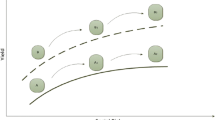Abstract
The scenarios presented in the preceding chapter represent two of the many possible future trajectories of the world. Their merit is primarily to highlight the extent of changes that can usefully be considered for the world’s food and agricultural systems over the next four decades, up to 2050. These changes are not unrelated to one another; future evolutions of consumption and production will interact, irrespective of the scenario. It is therefore necessary to foresee all of these changes coherently and comprehensively, taking all their technical, social, cultural, economic and political dimensions into account.
Access this chapter
Tax calculation will be finalised at checkout
Purchases are for personal use only
Similar content being viewed by others
Notes
- 1.
In any case, in the rich countries that have exceeded the annual mean currently situated at 3,000 kcal/cap/day, as in 2050 in Agrimonde 1.
- 2.
Mean availability for consumption is considered here to be equal to the availability and not to the ingestion of food, as available food is partially ingested and partially wasted. In terms of ingestion, humans’ net energy needs are between 2,000 and 3,000 kcal/day, depending on sex, height, weight and intensity of physical activity.
- 3.
Up to nearly 70 % according to the UN scenario, with a growth of urban populations from 2.8 billion in 2000 to 6.4 billion in 2050 (UN 2007).
- 4.
To be complete, it is necessary to point out a methodological limit to Agrimonde: as the quantitative model does not take into account the prices of products, it was not possible for us to examine the influence of food prices on consumers’ diets. Yet changes in consumption trends in OECD countries would be compatible with a scenario in which prices, especially of meat, remained high.
- 5.
However, nutritional recommendations for elderly people lead to a minor reduction in the energy intake. The risk is essentially under-nutrition in case of over-reduction. In particular, as the metabolisation of proteins becomes less effective with age, the protein intake must remain at least equal to that of adult men or women, and must be constituted primarily of animal proteins which are more easily metabolised.
- 6.
NHANES, Data on the Prevalence of Overweight and Obesity among Adults.
- 7.
World Health Statistics, WHO.
- 8.
That is, consumers who eat less fruit and vegetables than the recommended daily intake.
- 9.
Unless there is compensation, as in the US in the case of mitigation banking (www.mitigationbanking.org).
- 10.
Amongst others, the Universities of Berkeley (Department of Environmental Science, Policy and Management), Santa Cruz (Center for Agroecology and Sustainable Food System), Santa Clara (Environmental Studies Institute), and Davis (Agricultural Sustainability Institute).
- 11.
See for example the most recent results of the IMPACT model of the IFPRI (International Food Policy Research Institute), as published in the IAASTD Report (IAASTD 2009).
- 12.
The African, Caribbean and Pacific countries that signed the Lomé Convention and the Cotonou Agreement.
Author information
Authors and Affiliations
Corresponding author
Editor information
Editors and Affiliations
Rights and permissions
Copyright information
© 2014 © Éditions Quæ, 2014
About this chapter
Cite this chapter
Chaumet, JM. et al. (2014). Scenario-Based Insight into Food Behaviours, Technological Options and Trade. In: Paillard, S., Treyer, S., Dorin, B. (eds) Agrimonde – Scenarios and Challenges for Feeding the World in 2050. Springer, Dordrecht. https://doi.org/10.1007/978-94-017-8745-1_11
Download citation
DOI: https://doi.org/10.1007/978-94-017-8745-1_11
Published:
Publisher Name: Springer, Dordrecht
Print ISBN: 978-94-017-8744-4
Online ISBN: 978-94-017-8745-1
eBook Packages: Biomedical and Life SciencesBiomedical and Life Sciences (R0)




